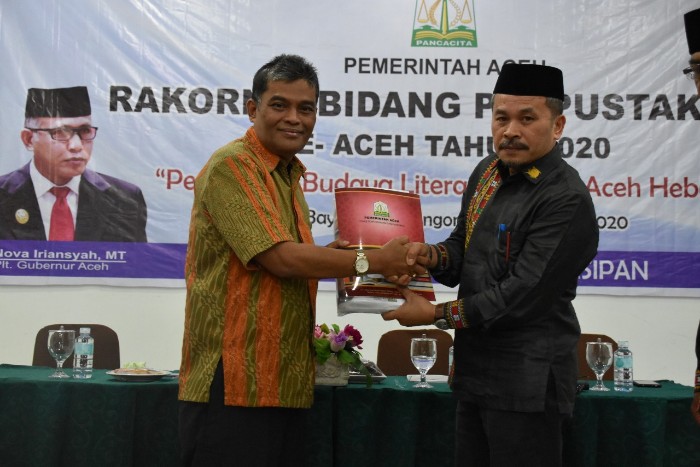Oleh : Dr. Joni MN, M.Pd.B.I*
PART ONE
Interest in using linguistic methods as one solution to an educational problem in the writer’s opinion is a big problem at present. Firstly, the focus is on language pedagogy in town of Takengon in central Aceh, Aceh Province. Because competence has a very close relationship with human reality itself, language competence is very important in language pedagogy or education of humanity. But the language competence is not only fluency in speaking as presented in a curriculum but also the language competence has a close relationship with human identity, what differentiates one from the other being in this world. According to Dardjowidjojo (2003: 237) the “language competence is nature, namely, the ability obtained through cultural and studying process”
Previously, writers have concluded that life in the world is just reflected from what happens in nature (Mulder, 1984: 33-34). From the beginning, man has been a social being and has lived in societies. In so doing, man has developed patterned ways of acting, talking, thinking and feeling. Groups have become sufficiently uniform and associate sufficiently with in those societies, that they constitute a culture. When a person comes into contact with people of another culture, they may notice that they speak a different language, dress differently, and have some characteristics of behavior that identity them as members of a different society.
So, to manage and preserve human life and culture in the Gayo plateau of Aceh so that there is suitable social compatibility with nature and Gayonese culture, the government of Aceh has made legislation called the Qanun regulation of Aceh. The Qanun of Aceh Province number 23 in 2002 is about management of education in Aceh Province, as follows;
PART XI
EDUCATION
Section 14
Clause 4
- Islamic education is education which is in accordance with Islamic teachings and Islamic culture.
- The purpose of clause 4 is that foreign educational institutions which operate in NAD to observe the philosophy and cultural values of the Acehnese community.
In Indonesian language:
Ayat 4
- Pendidikan Islami adalah pendidikan yang sesuai dengan ajaran agama dan kebudayaan Islam.
- Maksudnya ayat 4 kalau ada lembaga pendidikan asing yang beroperasi di NAD, juga harus memperhatikan filosofi dan nilai-nilai budaya masyarakat Aceh.
Section 19
Clause 2
All educators are obligated to:
- highly respect the culture, the unity of the nation;
- improve the quality of themselves personally, their abilities and their professional skills in accordance with the demands of progress in knowledge, technology and art.
- Preserve the good name of their profession and their organization so that they uphold the authority, the dignity and status of teachers, as well as secure the trust given them by the community and the nation.
In Indonesian language:
Ayat 2
Setiap tenaga kependidikan berkewajiban untuk:
- menjunjung tinggi kebudayaan dan persatuan bangsa;
- meningkatkan kualitas pribadi, kemampuan dan keterampilan professional sesuai dengan tuntutan perkembangan ilmu pengetahuan, technology, dan seni; dan
- menjaga nama baik profesi dan organisasi terkait dalam rangka mempertinggi wibawa guru, harkat dan martabat serta untuk menjamin kepercayaan yang diberikan oleh masyarakat dan Negara.
Section 30
Clause 2:
A foreign language can be used as a mediator in an Islamic School in as far as it may be needed to convey knowledge and/or certain skills.
In Indonesian language;
Ayat 2:
bahasa asing dapat digunakan sebagai bahasa pengantar pada madrasah dan dayah sejauh diperlukan dalam penyampaian pengetahuan dan/atau keterampilan tertentu.
Here, it is self-explanatory that an educator and a student must be able to have respect for the cultures and the nation. They should not merely introduce an un-measurable culture but be able to tighten the brotherhood or the relationship among citizens and have respect for humanity. There is no demarcation in linguistic usage, but every educator should take culture into account in their teaching and learning always.
Task – Based Language Teaching (TBLT) refers to an approach based on the use of tasks as the core unit of planning and instruction in language teaching. Some of its proponents (e.g., Willis 1996) present it as a logical development of communicative language teaching since it draws on several principles that formed part of the communicative language teaching movement from the 1980s (Lado, 1964). For example:
- Activities that involve real communication are essential for language learning.
- Activities in which language is used for carrying out meaningful tasks promote learning.
- Language that is meaningful to the learner supports the learning process.
The language teacher must know the target language well enough to be imitated by the students. Proficiency in the target language includes the four skills: listening, speaking, reading, and writing but not translation and interpretation, which are the separate professional skills essential for the interpreter but not for the language teacher as such. Linguistic knowledge is not enough to be able speak a language or qualify to teach it. Even the native speaker of a language cannot model the language or guide the students unless he or she can demonstrate its various elements. Students must know the chief differences and similarities of the two language systems and the major vocabulary facts of the target language.
In order to understand language more fully and to reflect this understanding in teaching, the teacher might familiarize them self with the major changes that the language has undergone in its history. Languages of the world share a number of features. However, each language also has its own unique reality, or spirit, since it is the expression of a particular group of people. The culture, as reflected in their own unique world view, is inseparable from their language.
The language teacher must understand the intimate relation between language and its culture. The students cannot go far into the target language without facing differences in cultural meanings, because the meaning expressed in a language is largely culturally determined. Although by the mid 80s, various advantages of teaching culture in foreign language classes were virtually universally accepted, and culture was widely taught in language classes, there were still problems about what should be taught and how culture could be taught most beneficially. These questions were faced more and more 1990s (Kitao, 2000).
One cannot understand a language fully without understanding at least some of the distinct cultural meanings expressed thorough it. This involves knowledge of specific facts concerning the cultural and some understanding of the major patterns of though, beliefs, traditions, and values that account for the way the people live and behave and give significance to their accomplishments. Something of the history, geography, and origins of the peoples who speak the language is necessary for an understanding of the culture and is therefore a qualification for professional competence.
Fries States this cases strongly; “To deal with the culture and life of a people is not just an adjunct of a practical language course, something alien and apart from its main purpose, nor added or not as time and convenience may allow, but an essential of every stage of language learning (Fries, 1955: 14)”.
This need is present even if the lecturers use the language exclusively as a tool and not as a complete educational experience, however, when the language is taught for its educational value, understanding cultural content is much more important.
The process of becoming a competent member of society is realized through exchanges of language in particular social situations and set store well to all of the societies’ culture. And if a complete educational experience is expected to the Students the lecturers in Central Aceh need to recognize and understand how people in a given Gayonese culture typically behave in common, everyday situations; they need to know the significant meanings that are associated with English and Gayonese words, and then they need to know that people act in a manner consistent with use of Indonesia or English language. Also if they use the mother tongue it is expected they must be polite because of their cultural frame of reference, because all people respond in culturally conditioned ways to basic human needs. In this case, the students and lecturers need the skills of analysis, hypothesis formation, and tolerance of ambiguity of language across three languages: Gayo, Indonesian, and English.
In experiencing the Gayonese culture much can be done to understand the target culture through the study of the English language. Moreover, by mastering the English language, students in Aceh gain the freedom to penetrate further into the Gayonese culture through what the people themselves write and say. Furthermore, the teachers may succeed in teaching cultural content or decide when the teachers should tackle it, since the teacher must come to grips with it from the beginning from this study and the teachers should also know the role of the Gayonese culture in English Language Teaching (E.L.T).
We can not understand another people’s language fully until we know more of their culture, and one can not grade assignments on the basis of language without systematically covering the culture as well. It is important to introduce cultural content as needed to make language material meaningful and to avoid misinformation.
Wittgenstein in Chaidar (2007: 31) stated language is used not only to say some logical propositions but used also for other means, such as to commend, question, announce, and to teach.
Additionally, Prof. Dr. Joko Nurkamto, M.Pd gave a lecture in 31st Juni 2008 at MPBI for the second Semester of Ahmad Dahlan University and said that language has two very important aspects. Firstly, one should focus on the meaning of language. Secondly one must focus on the form of the language. In real communication it is very important that meaning be stressed, where as the form just follows the situation and depends on the context; it is identified as part of a politeness principle.
Of course, appropriate language use cannot be separated from the courtesy and the culture of the language. Without knowing the culture, the learning of language especially English, will be difficult. We will be unable to get the meaning from the source language if it is not clearly connected with reality or it does not follow the situation and context of the language. For that reason lecturers, teachers, the users or native speakers of that language must be able to know the culture and context in order to communicate well in the social environment, such as in the school, especially in a classroom.
Continue …




















